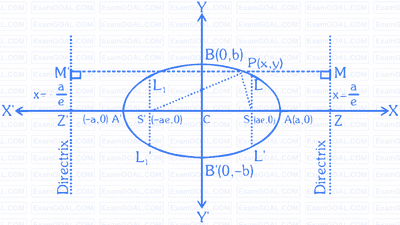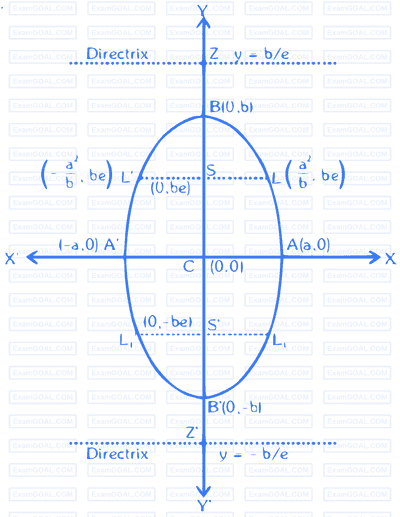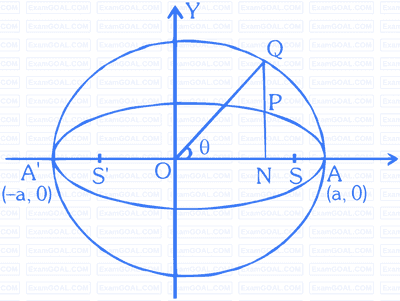STANDARD EQUATION AND DEFINITION
Standard equation of an ellipse referred to its principal axis along
the co-ordinate axis is $\frac{\mathbf{x}^2}{\mathbf{a}^2}+\frac{\mathbf{y}^2}{\mathbf{b}^2}=\mathbf{1}$. where $\mathrm{a}>\mathrm{b} $
and $ \mathrm{~b}^2=\mathrm{a}^2\left(1-e^2\right)$ $\Rightarrow \mathrm{a}^2-\mathrm{b}^2=\mathrm{a}^2 \mathrm{e}^2$. where $e=$ eccentricity $(0 < e < 1)$.

FOCI : S $\equiv(a e, 0) $ and $ S^{\prime} \equiv(-a e, 0)$
(a) Equation of directrices :
$ \mathrm{x}=\frac{\mathrm{a}}{\mathrm{e}} $ and $\mathrm{x}=-\frac{\mathrm{a}}{\mathrm{e}} \text {. } $
(b) Vertices :
$$ \mathrm{A}^{\prime} \equiv(-\mathrm{a}, 0) \quad \& \mathrm{~A} \equiv(\mathrm{a}, 0) . $$
(c) Major axis :
The line segment A'A in which the foci $\mathrm{S}^{\prime} \& \mathrm{~S}$ lie is of length $2 \mathrm{a} $ and is called the major axis $(\mathrm{a}>\mathrm{b})$ of the ellipse. Point of intersection of major axis with directrix is called the foot of the directrix (Z) $\left(\pm \frac{a}{e}, 0\right)$.
(d) Minor Axis : The y-axis intersects the ellipse in the points $B^{\prime} \equiv(0,-b) $and $B \equiv(0, b)$. The line segment $B^{\prime} B$ of length $2 b(b
(e) Principal Axis : The major \& minor axis together are called Principal Axis of the ellipse.
(f) Centre : The point which bisects every chord of the conic drawn through it is called the centre of the conic. $\mathrm{C} \equiv(0,0)$ the origin is the centre of the ellipse $\frac{x^2}{a^2}+\frac{y^2}{b^2}=1$
(g) Diameter : A chord of the conic which passes through the centre is called a diameter of the conic.
(h) Focal Chord : A chord which passes through a focus is called a focal chord.
(i) Double Ordinate : A chord perpendicular to the major axis is called a double ordinate with respect to major axis as diameter.
(j) Latus Rectum : The focal chord perpendicular to the major axis is called the latus rectum.
(i) Length of latus rectum :
$$ \left(L^{\prime}\right)=\frac{2 b^2}{a}=\frac{(\text { minor axis })^2}{\text { major axis }}=2 \mathrm{a}\left(1-e^2\right) $$
(ii) Equation of latus rectum : $x=\pm a e$.
(iii) Ends of the latus rectum are $\mathrm{L}\left(\mathrm{a}, \frac{\mathrm{b}^2}{\mathrm{a}}\right), \mathrm{L}^{\prime}\left(\mathrm{a},-\frac{\mathrm{b}^2}{\mathrm{a}}\right)$, $\mathrm{L}_1\left(-\mathrm{ae}, \frac{\mathrm{b}^2}{\mathrm{a}}\right)$ and $\mathrm{L}_1{ }^{\prime}\left(-\mathrm{ae},-\frac{\mathrm{b}^2}{\mathrm{a}}\right)$.
(k) Focal radii : $\mathrm{SP}=\mathrm{a}-e \mathrm{x}$ and $\mathrm{S} ' \mathrm{P}=\mathrm{a}+e \mathrm{x}$
$\Rightarrow \mathrm{SP}+\mathrm{S} ' \mathrm{P}=2 \mathrm{a}=$ Major axis.
(l) Eccentricity : $e=\sqrt{1-\frac{b^2}{a^2}}$
the co-ordinate axis is $\frac{\mathbf{x}^2}{\mathbf{a}^2}+\frac{\mathbf{y}^2}{\mathbf{b}^2}=\mathbf{1}$. where $\mathrm{a}>\mathrm{b} $
and $ \mathrm{~b}^2=\mathrm{a}^2\left(1-e^2\right)$ $\Rightarrow \mathrm{a}^2-\mathrm{b}^2=\mathrm{a}^2 \mathrm{e}^2$. where $e=$ eccentricity $(0 < e < 1)$.

FOCI : S $\equiv(a e, 0) $ and $ S^{\prime} \equiv(-a e, 0)$
(a) Equation of directrices :
$ \mathrm{x}=\frac{\mathrm{a}}{\mathrm{e}} $ and $\mathrm{x}=-\frac{\mathrm{a}}{\mathrm{e}} \text {. } $
(b) Vertices :
$$ \mathrm{A}^{\prime} \equiv(-\mathrm{a}, 0) \quad \& \mathrm{~A} \equiv(\mathrm{a}, 0) . $$
(c) Major axis :
The line segment A'A in which the foci $\mathrm{S}^{\prime} \& \mathrm{~S}$ lie is of length $2 \mathrm{a} $ and is called the major axis $(\mathrm{a}>\mathrm{b})$ of the ellipse. Point of intersection of major axis with directrix is called the foot of the directrix (Z) $\left(\pm \frac{a}{e}, 0\right)$.
(d) Minor Axis : The y-axis intersects the ellipse in the points $B^{\prime} \equiv(0,-b) $and $B \equiv(0, b)$. The line segment $B^{\prime} B$ of length $2 b(b
(e) Principal Axis : The major \& minor axis together are called Principal Axis of the ellipse.
(f) Centre : The point which bisects every chord of the conic drawn through it is called the centre of the conic. $\mathrm{C} \equiv(0,0)$ the origin is the centre of the ellipse $\frac{x^2}{a^2}+\frac{y^2}{b^2}=1$
(g) Diameter : A chord of the conic which passes through the centre is called a diameter of the conic.
(h) Focal Chord : A chord which passes through a focus is called a focal chord.
(i) Double Ordinate : A chord perpendicular to the major axis is called a double ordinate with respect to major axis as diameter.
(j) Latus Rectum : The focal chord perpendicular to the major axis is called the latus rectum.
(i) Length of latus rectum :
$$ \left(L^{\prime}\right)=\frac{2 b^2}{a}=\frac{(\text { minor axis })^2}{\text { major axis }}=2 \mathrm{a}\left(1-e^2\right) $$
(ii) Equation of latus rectum : $x=\pm a e$.
(iii) Ends of the latus rectum are $\mathrm{L}\left(\mathrm{a}, \frac{\mathrm{b}^2}{\mathrm{a}}\right), \mathrm{L}^{\prime}\left(\mathrm{a},-\frac{\mathrm{b}^2}{\mathrm{a}}\right)$, $\mathrm{L}_1\left(-\mathrm{ae}, \frac{\mathrm{b}^2}{\mathrm{a}}\right)$ and $\mathrm{L}_1{ }^{\prime}\left(-\mathrm{ae},-\frac{\mathrm{b}^2}{\mathrm{a}}\right)$.
(k) Focal radii : $\mathrm{SP}=\mathrm{a}-e \mathrm{x}$ and $\mathrm{S} ' \mathrm{P}=\mathrm{a}+e \mathrm{x}$
$\Rightarrow \mathrm{SP}+\mathrm{S} ' \mathrm{P}=2 \mathrm{a}=$ Major axis.
(l) Eccentricity : $e=\sqrt{1-\frac{b^2}{a^2}}$
ANOTHER FORM OF ELLIPSE

$$ \frac{x^2}{a^2}+\frac{y^2}{b^2}=1,(a < b) $$
(a) $\mathrm{AA}^{\prime}=$ Minor axis $=2 \mathrm{a}$
(b) $\mathrm{BB}^{\prime}=$ Major axis $=2 \mathrm{~b}$
(c) $\mathrm{a}^2=\mathrm{b}^2\left(1-\mathrm{e}^2\right)$
(d) Latus rectum
$$ \begin{aligned} &L^{\prime}=L_1 L_1^{\prime}=\frac{2 a^2}{b} . \\\\ &\text { equation } y=\pm b e \end{aligned} $$
(e) Ends of the latus rectum are:
$$ \mathrm{L}\left(\frac{\mathrm{a}^2}{\mathrm{~b}}, \mathrm{be}\right), \mathrm{L}^{\prime}\left(-\frac{\mathrm{a}^2}{\mathrm{~b}}, \mathrm{be}\right), \mathrm{L}_1\left(\frac{\mathrm{a}^2}{\mathrm{~b}},-\mathrm{be}\right), \mathrm{L}_1^{\prime} \left(-\frac{\mathrm{a}^2}{\mathrm{~b}},-\mathrm{be}\right) $$
(f) Equation of directrix $y=\pm \frac{b}{e}$.
(g) Eccentricity $: e=\sqrt{1-\frac{\mathrm{a}^2}{\mathrm{~b}^2}}$
POSITION OF A POINT W.R.T. AN ELLIPSE
The point $P\left(x_1, y_1\right)$ lies outside, inside or on the ellipse according as :
$$ \frac{x_1^2}{a^2}+\frac{y_1^2}{b^2}-1><\text { or }=0 $$
$$ \frac{x_1^2}{a^2}+\frac{y_1^2}{b^2}-1><\text { or }=0 $$
AUXILIARY CIRCLE/ECCENTRIC ANGLE

A circle described on major axis as diameter is called the auxiliary circle. Let be a point on the auxiliary circle such that QP produced is perpendicular to the -axis then and are called as the CORRESPONDING POINTS on the ellipse and the auxiliary circle respectively. ' ' is called the ECCENTRIC ANGLE of the point on the ellipse . Note that
Hence "If from each point of a circle perpendiculars are drawn upon a fixed diameter then the locus of the points dividing these perpendiculars in a given ratio is an ellipse of which the given circle is the auxiliary circle".
PARAMATRIC REPRESENTATION
The equations and together represent
the ellipse where is a parameter (eccentric angle).
Note that if is on the ellipse then ; is on the auxiliary circle.
the ellipse where is a parameter (eccentric angle).
Note that if is on the ellipse then ; is on the auxiliary circle.
LINE AND AN ELLIPSE
The line meets the ellipse in two real points, coincident or imaginary according as is or .
Hence is tangent to the ellipse if .
The equation to the chord of the ellipse joining two points with eccentric angles is given by
.
Hence is tangent to the ellipse if .
The equation to the chord of the ellipse joining two points with eccentric angles is given by
.
TANGENT TO THE ELLIPSE
(a) Point form :
Equation of tangent to the ellipse $\frac{x^2}{a^2}+\frac{y^2}{b^2}=1$ at its point $\left(x_1, y_1\right)$ is $\frac{x x_1}{a^2}+\frac{y y_1}{b^2}=1$
(b) Slope form :
Equation of tangent to the ellipse $\frac{x^2}{a^2}+\frac{y^2}{b^2}=1$ whose slope is ' $m$ ', is $y=m x \pm \sqrt{a^2 m^2+b^2}$
Point of contact are $\left(\frac{\pm a^2 m}{\sqrt{a^2 m^2+b^2}}, \frac{\mp b^2}{\sqrt{a^2 m^2+b^2}}\right)$
(c) Parametric form :
Equation of tangent to the given ellipse at its point $(a \cos \theta, b \sin \theta)$, is $\frac{x \cos \theta}{a}+\frac{y \sin \theta}{b}=1$
Equation of tangent to the ellipse $\frac{x^2}{a^2}+\frac{y^2}{b^2}=1$ at its point $\left(x_1, y_1\right)$ is $\frac{x x_1}{a^2}+\frac{y y_1}{b^2}=1$
(b) Slope form :
Equation of tangent to the ellipse $\frac{x^2}{a^2}+\frac{y^2}{b^2}=1$ whose slope is ' $m$ ', is $y=m x \pm \sqrt{a^2 m^2+b^2}$
Point of contact are $\left(\frac{\pm a^2 m}{\sqrt{a^2 m^2+b^2}}, \frac{\mp b^2}{\sqrt{a^2 m^2+b^2}}\right)$
(c) Parametric form :
Equation of tangent to the given ellipse at its point $(a \cos \theta, b \sin \theta)$, is $\frac{x \cos \theta}{a}+\frac{y \sin \theta}{b}=1$
NORMAL TO THE ELLIPSE
(a) Point form : Equation of the normal to the given ellipse at is
.
(b) Slope form : Equation of a normal to the given ellipse whose slope is ' ' is .
(c) Parametric form : Equation of the normal to the given ellipse at the point is .
.
(b) Slope form : Equation of a normal to the given ellipse whose slope is ' ' is .
(c) Parametric form : Equation of the normal to the given ellipse at the point is .
CHORD OF CONTACT
If and be the tangents from point to the ellipse
then the equation of the chord of contact is or at
then the equation of the chord of contact is or at
PAIR OR TANGENTS

If be any point lies outside the ellipse and a pair of tangents PA, PB can be drawn to it from .
Then the equation of pair of tangents of and is
where
i.e.
DIRECTOR CIRCLE
Locus of the point of intersection of the tangents which meet at right angles is called the Director Circle. The equation to this locus is i.e. a circle whose centre is the centre of the ellipse and whose radius is the length of the line joining the ends of the major and minor axis.
EQUATION OF CHORD WITH MID POINT (x1 , y )
The equation of the chord of the ellipse ,
whose mid-point be is
where
i.e.
whose mid-point be is
where
i.e.